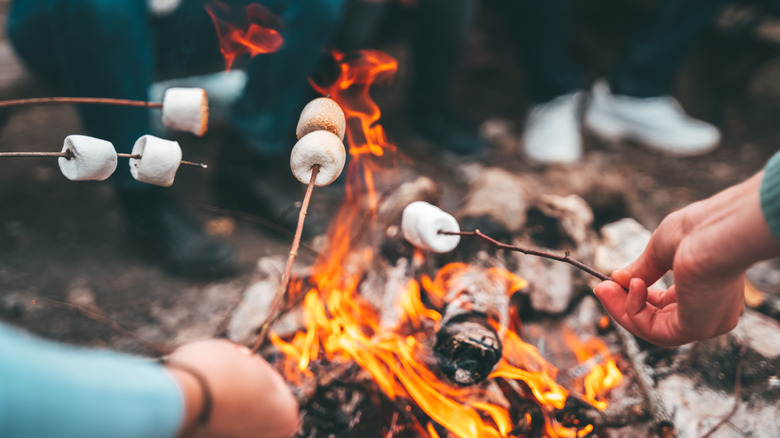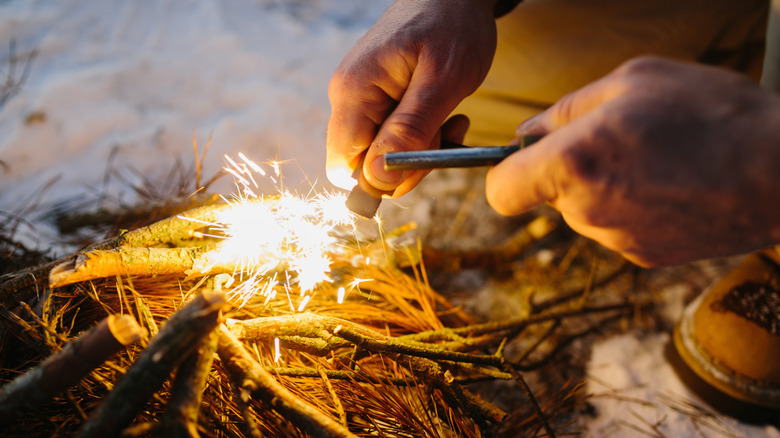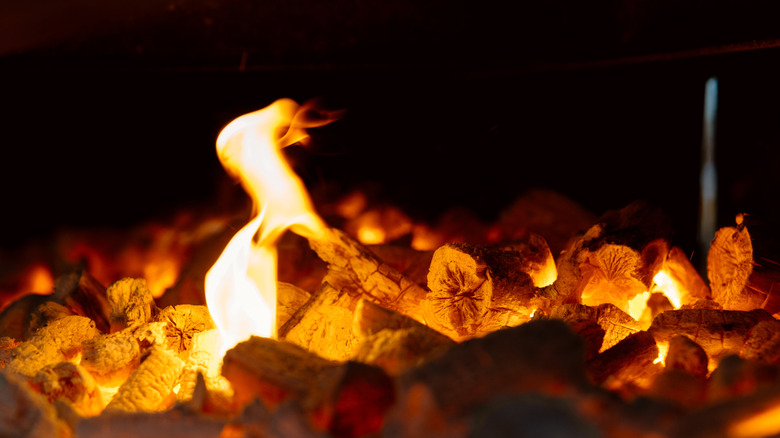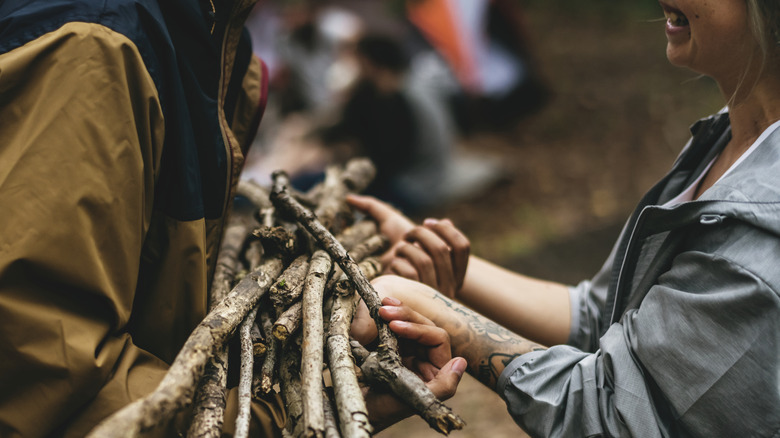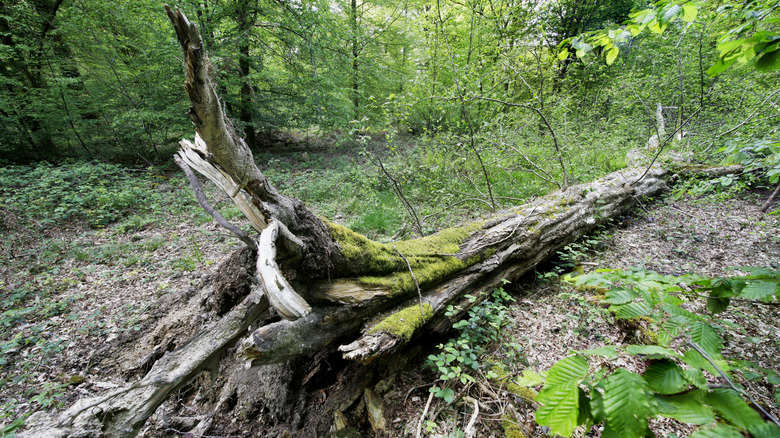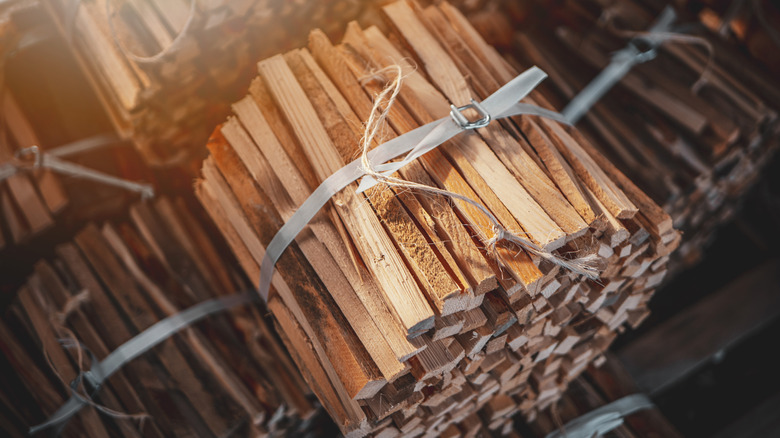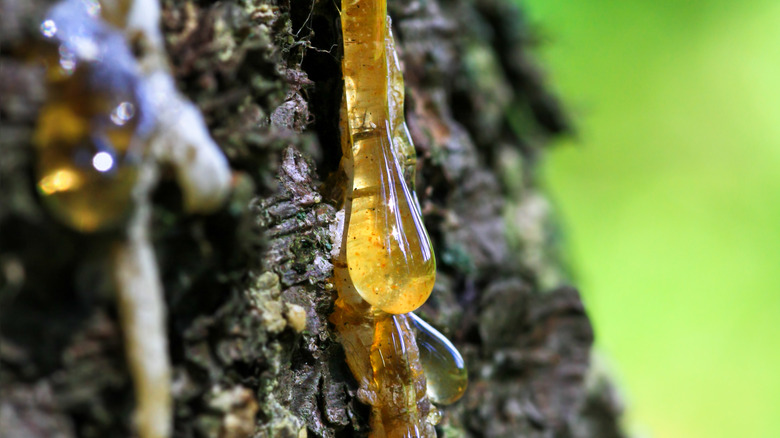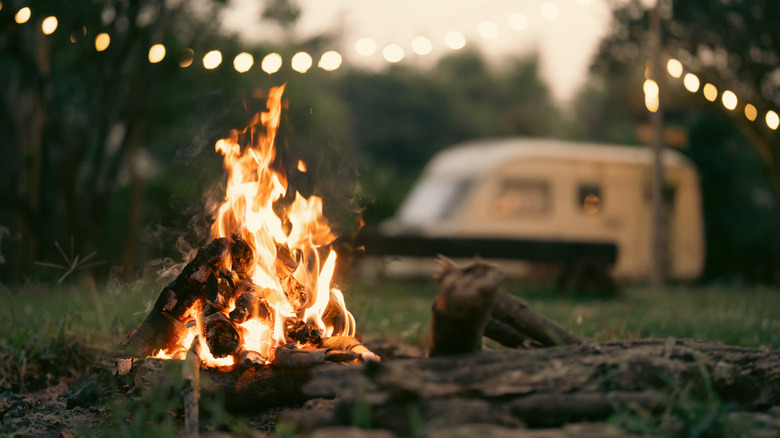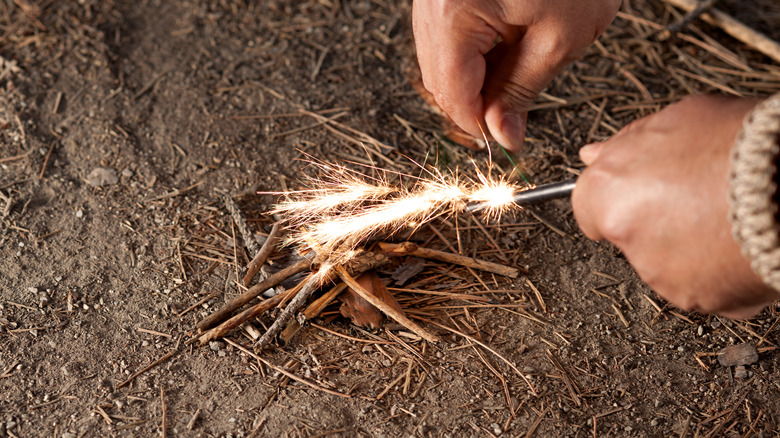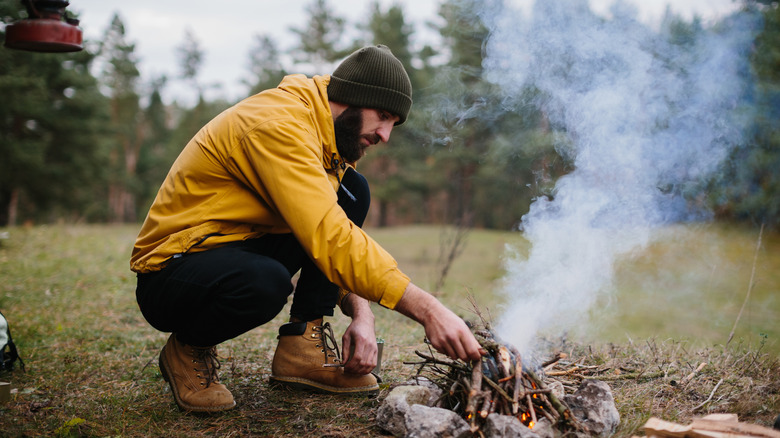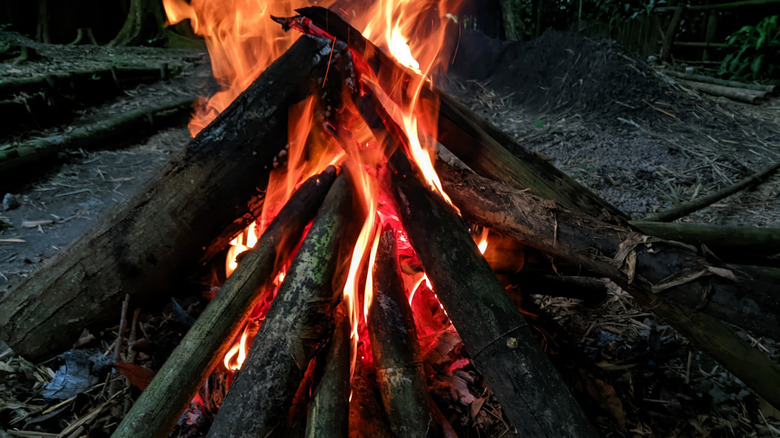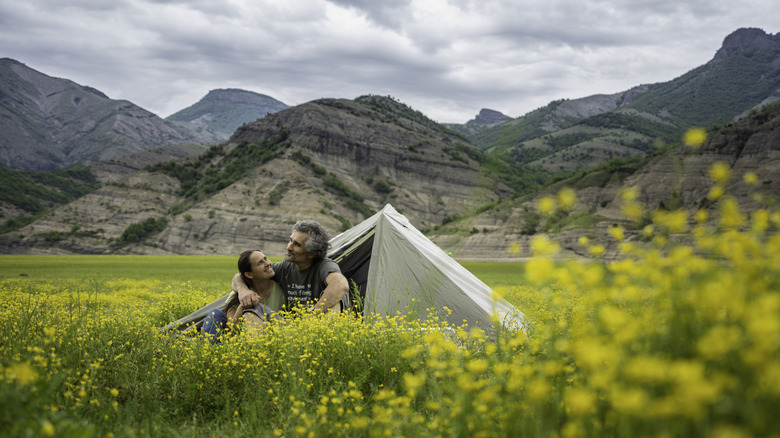Build A Perfect Campfire Every Time With These Tried-And-True Methods
So many people have been here before: You arrive at the campsite, and instead of a fun, relaxing setup process, the site is inundated with stress and frustration. Plenty of features can strain you and your campmates, from a tent not prepared for a rainstorm to poor packing that leaves you light on entertainment. But one element is frequently at the center of a campsite's stress: The fire-making process often feels like trying to crack a code rather than just lighting a few twigs and watching the blaze grow naturally. What makes this disconnect so frustrating is the reality that it doesn't have to be this way.
What initially appears to be a secret sauce is just good fire management. Understanding the core building blocks of creating a healthy fire is all it takes to construct the perfect campfire and get your food preparation and warmth source blazing and ready for your relaxation needs. In an exclusive conversation with Tom McElroy, owner of Wild Survival LLC, Explore learned about the specifics of planning and executing the perfect fire-building effort. McElroy highlighted a few problem areas that often derail the creation of a campfire and gave us some key tips on how to stay safe around an established fire.
Start with quality tinder material
McElroy starts us out with an important setup step. "While there are various methods to building a campfire, they all essentially have to follow the basic universal rules. The first step to making any campfire is tinder," he says. Tinder is the fire starter material that all good flames are built upon. Unfortunately, it's easy to discount the value of this early starting material. Since a fire will light without tinder, novice campers might skip ahead and look to get their campfire going with kindling instead. While it's possible to make the jump and end up with a fire that serves your cooking or heat needs, the extra step actually speeds up the process immensely.
Tinder material catches fire when contacted by sparks, giving a fire the rapid transition from unlit material to the raging inferno that most campers expect. "Anything from shredded paper, to buffed inner bark of a tree, or cattail down" can be used as a base to grow your campfire. Hunting for this material will set a good fire apart from one that continues to give you problems during the lighting phase and throughout your trip. Gathering the right supplies makes all the difference here. Alternatively, backpackers should consider using dryer lint to make starting a campfire a breeze.
Kindling is an underappreciated essential
With the value of tinder in mind, fire builders will also want to develop strategies for finding one more essential ingredient to a roaring fire. McElroy told us that when building a campfire, "You absolutely must not short-cut the process of starting with a large amount of very thin, dry sticks." These sticks, twigs, and other light materials are your kindling. Much like the tinder, which provides your starting point, kindling can sometimes be undervalued by those new to the campfire-building process.
It might be tempting to think of this as a small stepping stone between the ignition and larger logs that keep the fire going strong into the night. You'll need plenty of this intermediate fire-making material; overdoing it is likely a good idea. "Kindling is the secret between having a fire that lights right away versus having a fire that takes forever to light," the camping expert adds.
Continue collecting kindling and tinder material, even if you don't think you need it
Kindling acts as a second gear in the fire-making process. Once your fire is lit, adding kindling will aid its growth from a small ember into a large flame that's ready to support the density of larger logs. Fortunately, unlike those logs and other flammable materials, you can't add the kindling too early. You also can't overdo it with the kindling. It won't harm your fire if you continue adding these small twigs to the pile even after it's ready to support larger segments.
McElroy suggests making the kindling collection a central component of your early campsite setup tasks. "You should be in the habit of collecting little thin sticks on your way to your camp area, and every time you wander from camp. You'll never regret having too much fire starter," he says. "Make sure you get more kindling bundles than you think you need, at least ... [to the point that] you can't wrap both hands around" the whole pile.
Importantly, the best kindling is elevated but not on the ground
Finally, when gathering a stockpile of kindling, it's critically important to know exactly where to look. McElroy told us that the best kindling you'll find is near, but not on, the ground. This is because the ground is frequently damp (although there are genius tips for starting a campfire with wet wood). Early in the morning, dew often coats the ground, and throughout the day, this part of the landscape will remain the most shielded from the sun's rays and the drying effects of the wind. "Ideally, collect the kindling off the ground. Look into the trees to see if there is a dead [or] fallen branch that is off the ground that you can break into kindling."
Dead branches are particularly useful for this task as they are excessively dry in many cases. When branches fall off trees or become damaged and die, they stop drawing water from the tree. Over time, these branches become increasingly dried out and often pose a natural fire risk. This phenomenon isn't great for a local forested area near your home during a drought, but it's ideal for a camper on the hunt for pristine kindling materials. Dry, dead tree branches are perfect for fire lighting; they easily break into smaller pieces. McElroy notes that sky-facing areas of branches that have fallen and those that remain elevated (perhaps on a tree stump) will be the driest. "These will be dryer as they catch the sun and wind more and are not in contact with the damp ground."
Don't leave these components too large
Regarding kindling and the larger log segments you'll use to keep the fire going, size can pose one of the greatest barriers to success across the entire experience. According to McElroy, "The biggest mistake people make when building a fire is they attempt to light sticks that are too big right off the bat." Instead, he recommends keeping things relatively tiny: "Kindling should be about a toothpick size in diameter, and you need a lot."
Large sticks and logs require a lot more effort to catch fire. This has to do with the relationship between volume and surface area. Smaller kindling sticks are lightweight and feature a greater surface area in proportion to their volume. This allows more of the material to interact with the existing fire and reach ignition to sustain continued growth. A larger log is far denser; therefore, much less of its total volume will interact with the chemical processes taking place in a fire.
An inappropriate ratio such as this seems to stifle the fire, but what's happening is that carbon in the wood is heating up and vaporizing. A larger piece of wood heats slower and takes longer to reach ignition. It also reduces the overall temperature of the fire when you place a cumbersome piece of wood on the pile. If you aren't careful, these two hang-ups can combine and allow the fire to die out before the newest addition has reached the ignition stage to sustain itself.
Look for birch bark and pine sap, too
In addition to kindling and other fire-starting materials you'll need to get your blaze going, McElroy suggests seeking a secret weapon that can be found in the forests, too. "Get familiar with birch bark and pine sap as an amazing ignitor, tinder, or kindling. If you can find either of these, you should be able to get a fire going and keep it going even in a rainstorm." Pine sap, in particular, is a versatile solution for many outdoor tasks. It can be used as a natural glue, bug repellent, wood sealant, and a rapid-fire starter. The sap you'll find in the wild is actually a resin that can be scraped off the bark.
Anytime a tree is damaged, particularly pines, some of the sap flowing within the plant oozes out to cover up and seal the damaged area. This works much like how our blood clots to seal a cut. Scraping the resin off a tree won't harm it (in the same way a scab sits atop a closed wound) and offers an incredible asset. Birch trees feature a papery bark that also contains a bountiful harvest of natural oils. It's a thin bark that's ideal for these early fire-starting needs, just like sappy resin.
Clear a dedicated area for your fire
With the materials collected, campers will eagerly prepare to begin building their fire. However, there's an important step standing between collection and tinder lighting. Before striking your match or pulling out the flint to generate sparks, you'll need to select a safe, efficient location to build the campfire. In some campsites, there may be a dedicated spot, and the selection process will be pretty simple. In other instances, you'll need to do the work yourself and choose an advantageous location.
McElroy states, "To make fires safe, be sure to clear the area around the fire." Additionally, "Make sure there is nothing directly overhead, and keep an eye out for sparks — especially if you are in a wildfire prone area." Being diligent in this regard prevents flames from inadvertently setting ablaze an overhanging tree. Fire is arguably the most important primitive tool that humans have successfully harnessed. Humans also appear to have learned to utilize the smoke from fires to ward off predators and insects. Today (and likely in antiquity), campers add herbs to the fire to buff the smoke with additional bug-repellent properties.
However, smoke and flames can also pose a significant risk. Placing your campfire too close to your tent or allowing it to billow smoke with reckless abandon can bring health risks. It will also stick to your clothing and add unwanted odors after the fact (Pro tip: baking soda can be a real camping lifesaver in these circumstances). Keep the area clear to prevent accidental contact with the flames and smoke.
To build a steady fire, light your tinder before placing anything else in the fire pit
After selecting your campfire location and gathering the materials you'll need, lighting the fire is the next step in your campsite setup. McElroy states, "In order for a campfire to take-off the second the flame hits it, you must have a good amount of fluffy, dry, flammable material." He adds, "Tinder gives you [an] initial burst of flame and heat." From here, you'll carefully stoke the embers to grow a single spark into a healthy blaze. In some instances, it may be useful to build up a log structure on top of your tinder, but these revolve around more advanced fire-making approaches. For the basic campfire build, placing only tinder in the fire pit allows you to access it from every side, adding additional material when needed or blowing a stream of air into the mix to help build up the fire.
Your tinder will often burn up fairly quickly. This is especially true if you light a small amount of the flammable material to begin the fire. Much like the kindling that comes after it, adding more tinder than is strictly needed won't pose any real trouble unless you start wantonly throwing light material around that can be caught up in the wind. Keeping your tinder contained and building the early phase of the fire slowly allows you to manage its flames and grow the inferno into the size you require carefully and with total control.
After it's established, add increasingly larger sticks and logs to solidify the fire
Kindling comes second to build up that initial spark and collection of small flames into a true fire. McElroy tells us, "From here, you slowly add sticks and logs of larger dimensions, letting the previous bundle of sticks light the subsequent, thicker layer." If done correctly, each new addition will add to the blaze rather than reduce it while the fire ignites the new material. As he previously noted, adding plenty of kindling at this stage will help keep the fire healthy and burn at full volume later. The kindling (or supporting fire-starting material like pine sap) launches a fire into its full potential.
"These sticks should light quickly after your tinder ignites and build enough heat to light the larger sticks," the fire expert offers. Fires grow exponentially in this regard, with greater volumes of lit material gaining the ability to ignite larger fuel sources even faster. Build your fire slowly and wait until each new layer of sticks has ignited to quickly and efficiently ramp up the fire in preparation for an evening of sitting and chatting or even to support cooking needs.
You might consider different campfire types to support specific needs
Aside from the basics of building a healthy fire, there are a number of layouts that you might utilize to support different needs. The "log cabin" campfire-starting method is a foolproof option. This involves stacking large logs in layers perpendicular to the lower rung (like a Jenga tower missing its middle bricks). Adding new logs is easy; air flows through the structure easily to keep the fire lit.
A lean-to campfire is another option that campers might erect. This features one open side and a wind block built around the remainder of the fire (or just on one side). This fire structure demands a quick replenishment schedule since it burns quickly, but it can survive extreme winds that might put other fires out and produce a lot of heat. This makes a great option for those camping in significantly cold conditions. These fires are also easy to build and can get going quickly.
Yet another option is the platform fire. Establishing the primary flame on top of a platform of logs rather than in a dug-out pit or bare ground delivers a built-in fuel source that allows the fire to continue burning unattended for a long time. This fire can often produce a lot of smoke, but it's a good option for a campsite that needs the fire to continue burning long into the night.
Stay safe around an open flame, and care for the environment as you pack up to leave
Finally, ensuring good stewardship of the land is something that every camper will need to keep in mind. Whenever you head out into the wilderness, you enter the natural world that supports a thriving but often fragile ecosystem. A few bad decisions by those enjoying the natural wilderness can snowball into a major threat to the recreation area.
Feeding seagulls, for example, seems harmless. However, it can lead to aggressive behavior from the birds, and they may even become distracted, leading to carelessness around cars and other vehicles that increase the likelihood of death among the population. Animals of all varieties can also become dependent on human interaction for their food, disrupting the natural balance in a meaningful way. Remembering to clean up your campsite when the trip begins to wind down is one way to ensure you're always practicing good stewardship.
McElroy also tells us that good decision-making is a core component of practicing solid fire safety. He noted the value of placing your fire away from flammable material you don't intend to burn. It's your job to keep the fire contained, and a spark that jumps out of the firepit and contacts dry brush in the surrounding area can spell disaster for you and countless others.
